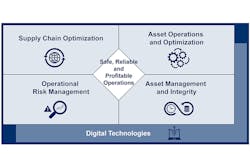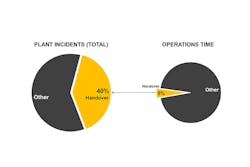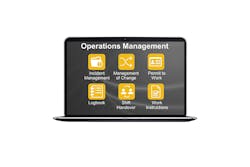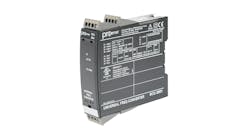As markets change and global competition intensifies, manufacturers are faced with the challenge of minimizing costs and ensuring high profitability. At process manufacturing sites, it is particularly important to improve operational efficiency, facility utilization and productivity — while also ensuring safety.
In response to the above-mentioned needs, end users at process industry firms need solutions that use digital technologies to optimize and automate their business processes. These solutions help firms optimize their supply chains, and the operation of their plants and facilities. They also facilitate the management of organizational risks and maximize the efficiency of plant assets to ensure safe, reliable and profitable operations (see figure below).
Figure 1. The proper use of digital technologies will result in safe, reliable and portable operations in these four areas. Graphic courtesy of Yokogawa
As the Internet of Things (IoT) and the use of big data and artificial intelligence (AI) gain momentum, attention is swinging to how the collection, analysis and digitization of data can add value by identifying problems at an early stage. This helps process plants and facilities make their operations more efficient by enhancing management processes, optimizing supply chains and accelerating decision making.
By digitizing and standardizing information based on accumulated know-how and facilitating the exchange of information within and among groups of plant personnel, the right software in the hands of trained plant personnel can improve work efficiency and deliver other benefits including knowledge retention and regulatory compliance. This is done by using specially designed operations management software to digitally document best practices so they can be followed by all personnel. Without this type of software, plant operations vary from shift to shift due to different personnel, which often reduces efficiency, and sometimes causes plant upsets and incidents due to human factors.
Figure 2. Plant incidents are eight times more likely to occur during handovers, often due to a lack of digitized documentation regarding operations during the prior shift. Graphic courtesy of ARC
For example, managing shift handovers correctly is key to improving plant performance and reducing incidents. When handovers are conducted manually with handwritten notes and verbal instructions, mistakes and omissions are likely to occur frequently, and the task will be time-consuming.
Human factor issues
Human factors are often at fault for issues impacting operational efficiency at process plants, including unplanned downtime. In many cases, issuance of work instructions, monitoring of progress and other critical activities are conducted per verbal direction and without any written documentation. This absence of digital records can lead to a number of problems, including: Making it impossible to check work progress in real time; taking a long time to collect necessary information; creating opportunities for errors when adding information to shift handover reports; and making it difficult to locate and retrieve records with respect to past operations.
Safety can also be compromised by issues such as the failure to report near misses and incidents, along with whatever countermeasures were executed, and misunderstandings between field workers and control room operators. The figure below illustrates one of the most serious human factor issues in process plants, showing how 40 percent of plant incidents occur during shift handovers, even though these transition periods only represent 5 percent of plant operations time.
Due to these and other issues, there is a growing awareness in many process plants and facilities of the need for operations management solutions to enhance efficiency and safety by ensuring operational continuity and retention of knowledge. The solution to these human-factor problems and issues is deployment and use of the right operations management software solution.
Operations management software digitizes and standardizes a wide variety of information for sharing among plant operators and managers. This can range from information on anything unusual noted in plant operations such as task status or the workflow for a specific operation.
This type of software helps to improve reliability and safety by ensuring that plant personnel have the information they need to carry out their work correctly, and it also helps to improve operational efficiency. These solutions support safe and secure operations management by recording events and work performed based on written instructions, and enable the retrieval and use of information representing the knowledge and know-how of skilled operators.
To equip plant personnel with the tools they need, operations management software should be able to:
- Document, digitize, manage and share work instructions and information regarding the actions by operators in the central control room
- Prepare reports for shift handover.
- Manage incidents by ensuring the workflow for the handling of near misses and incidents is carried out in a unified manner, from the recording of the incident occurrence to the implementation of countermeasures and verification of results.
- Manage change by ensuring the workflow for changing plant facilities or operation processes is carried out in a unified manner. These work flows may involve the performance of risk assessments, the reporting of changes to relevant personnel, and the actual implementation of changes to a plant operation.
- Digitize the workflow for obtaining permission to perform field work.
Applying process plant operations management software
Figure 3. Operations management software should include modules for digitizing and managing common process plant tasks. Graphic courtesy of Yokogawa
The best software will only help plants improve performance if it is implemented correctly. A key to successful implementation is ease of use, which starts with a well-designed and intuitive user interface (UI). With the right UI, operators can understand with a single glance the status of an operation, and they can quickly find whatever information they need.
The figure above depicts an operations management software screen with six modules that represent key areas of plant operations, and each can be used to digitize, manage and share information. Ideally, these modules should be linked electronically so relevant information from one module is automatically transferred, for example from the operators’ logbooks to shift handover and work instructions. Automatic transfer not only saves time, but also reduces errors.
Operations management software standardizes this process because data is entered into each module in a consistent format by each operator via a simple process whereby personnel fill in the blanks on a form. In addition to facilitating knowledge transfer, digitization provides a record to ensure handovers are performed in a consistent manner in keeping with plant procedures and policies. When used correctly, operations management software saves time and maintains data integrity by linking data on various systems and business work flows. This and other capabilities make the software easy to use for the access, management and analysis of data.
Figure 4. Successful handover from one shift to the next is a five-step process, facilitated by using operations management software instead of relying on verbal instructions. Graphic courtesy of ARC
Digitizing and automating shift handovers
The figure above shows the steps required during handover of plant control by operators from one shift to the next. In many plants, these steps are performed on an ad hoc basis via verbal instructions — an inconsistent process fraught with opportunities for error.
Operations management software intensively manages this process by making data and information digitally available during shift handover. The software provides auto generation of shift handover reports based on shift configuration per roles, plant locations and departments. Auto compilation of shift reports is based on shift data for log, instructions, process data, trends and excursions, overrides, incident management, work permits, etc.
Step 1 is to prepare handover, where operators from the outgoing shift use the logbook module in the operations management software to document the main activities performed during their shifts. The logbook module saves time spent creating logs manually while maintaining data integrity. Step 2 is where incoming shift operators review the logbook and shift handover information. Step 3 is walk down of the workstation hosting the operations management software, where incoming shift operators ask questions of outgoing operators if any item is unclear. Step 4 is information exchange, where data and information are officially transferred from one shift to the next, followed by Step 5, the sign off for handover.
Conclusion
Digitizing and automating handovers with operations management software improves shift handover and plant performance, reduces risk and saves time. Once shift handover is digitized and automated, other areas of plant operation such as incident management, work instructions and permits to work can benefit from a similar upgrade.







